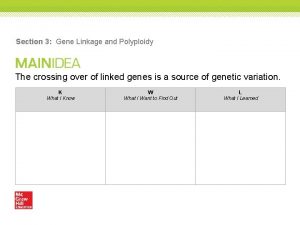Colchicine 1 1 2 2 1 Polyploidy Induction

- Slides: 1

Colchicine 처리에 의한 구기자 배수체 유도 충남농업기술원 인삼약초연구소, 충남농업기술원 인삼약초연구소 청양구기자시험장 김수동 1), 한승호 1), 박영춘 2), 이보희 2), 김현호 1)* Polyploidy Induction by Colchicine Treatment in Lycium Chinense M. Su Dong Kim 1), Seung Ho Han 1), Young Chun Park 2), Bo Hee Lee 2) and Hyun Ho Kim 1)* 1)Ginseng & Medicinal Plant Research Institute, CNARES, Geumsan 32723, Korea. 2)Cheongyang Boxthorn Experiment Station Ginseng & Medicinal Plant Research Institute, CNARES, Cheongyang 33319, Korea. Objectives Recently new breeding goal setting is required to develop new boxthorn variety with superior treats of bigger fruits, higher yield in fruits and sprout, pest tolerance, higher medicinal functionality, and self-compatiblity. Various genetic resources also should be retained for this goal. This study was carried out to obtain boxthorn tetraploid for breeding resource. Table 3. Induction of polyploid plants by colchicine treatment in Cheongyang-jaerae. Materials and Methods Colchicine concentration and treatment time for polyploid induction were 0. 1, 0. 2, 0. 4, 0. 6% and 12, 24, 36, 48 hours respectively. Polyploid was identified by chromosome numbering of individuals by aceto-carmine stain which were examined for polyploid by flow cytomertry(Partec, PA-1) in advance. Z Chloroplast no. No. of per guard cell plant below 20 171 20〜 25 Ploidy levelz No. of polyploid Aneuploid Tetraploid 0 0 0 5 0 0 0 25〜 30 9 0 0 0 over 30 10 8 3 5 Total 195 8 3 5 : Ploidy level was determined by chromosome number. Results Table 1. Comparison of survival rate of cuttings according to different combinations of colchicine concentration and treatment duration in Cheongyang-jaerae (Lycium chinense). Colchicine concentration (%) Treatment (hour) No. of treated cutting No. of cutting survived Survival rate (%) 0. 1 12 24 36 48 50 50 20 19 21 8 40 38 42 16 0. 2 12 24 36 48 50 50 24 18 15 3 48 36 30 6 0. 4 12 24 36 48 50 50 19 13 8 4 38 26 16 8 0. 6 12 24 36 48 50 50 9 6 8 0 18 12 16 0 Fig. 3. Chromosome number of Cheongyang-jaerae. Diploid(2 n=2 x=24, top of left), aneuploid (2 n=4 x-2=46, top of right, 2 n=4 x-1=47, bottom of left) and tetraploid (2 n=4 x=48, bottom of right) in Lycium chinense. Table 4. Survival rate and polyploidy induction by colchicine treatment in cutting of Lycium chinense. Table 2. Distribution of survived cuttings according to chloroplasts number in stomata guard cell. Colchicine concentration (%) Treatment (hour) below 20 (%) 20~ 25 (%) 25~ 30 (%) above 30 (%) 0. 1 12 24 36 48 90. 0 84. 2 76. 2 50. 0 75. 1 100 94. 4 93. 3 66. 7 88. 6 89. 4 84. 6 100 75. 0 87. 3 100 75. 0 91. 7 10. 0 0 9. 5 0 4. 9 0 0 0 7. 7 0 0 1. 9 0 0 0 5. 3 4. 8 12. 5 5. 7 0 0 0 33. 3 8. 3 5. 3 7. 7 0 25. 0 9. 5 0 0 25. 0 8. 3 0 10. 5 9. 5 37. 5 14. 3 0 5. 6 6. 7 0 3. 1 5. 3 0 0 0 1. 3 0 0 Mean 12 24 36 48 0. 2 Mean 12 24 36 48 0. 4 Mean 12 24 36 48 0. 6 Mean z Colchicine Concentration (%) Treatment (hour) Survival rate (%) Polyploid rate (%) 0. 1 12 24 36 48 40 38 42 16 0 5. 3 4. 8 37. 5 0 2. 0 6. 0 0. 2 12 24 36 48 48 36 30 6 0 5. 6 6. 7 0 0 2. 0 0 0. 4 12 24 36 48 38 26 16 8 5. 3 0 0 0 2. 0 0 0. 6 12 24 36 48 18 12 16 0 0 0 0 0 Efficiencyz (%) : Efficiency; (Survival rate × polyploid rate)/100. Conclusion Fig. 1. Comparison of chloroplasts number in stomata guard cell between Cheongyangjaerae(left) and a tetraploid line derived Fig. 2. Flow cytometry analysis of DNA content of diploid(left) and tetraploid(right) plants. When cuttings of Cheongyang-jaerae were treated by colchicine to induce tetraploid, survival rate decreased as colchicine concentration and treatment time increased. Rate of individuals having over 30 chloroplast number of stomata guard cell was highest as 37. 5% in colchine 0. 1% and 48 hours treatment. 8 of them were identified as polyploid by flow cytometry and tetraploid induction efficiency was highest as 6. 0% in colchine 0. 1% and 48 hours treatment. According to chromosome number examination, 3 of 8 individuals were aneuploid and 5 were tetraploid.

